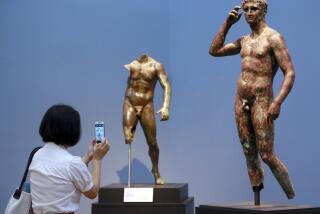Mussolini ‘Art’ at Home on the Range in Missouri
- Share via
SHELDON, Mo. — Jay Anderson never paid much attention to the big copper medallions his father mailed home from Italy at the end of World War II.
He hung a couple of the sculptures--one shows a train, another a harvest scene--on the walls of his den. Another is over the front door, and he’s stashed a fourth in the barn of his cattle ranch on this stretch of prairie where southwest Missouri meets Kansas.
Now the Italian government wants back what it says are valuable works of art that were plundered from a shrine in Rome. That’s all right by Anderson, who is willing to swap.
“It’s sort of like if you have a velvet Elvis on the wall,” he says, gesturing toward the hubcap-size, square-shaped sculpture of the harvest. “I mean, who would want this?”
Historians, for one. The hammered copper creations were part of a mural at one of Benito Mussolini’s principal Fascist shrines in Rome and depict, experts say, the dictator’s plans to re-create a modern version of the Roman Empire. They were created by Antonio Munoz, a prominent Italian artist from the first half of this century.
“They’re very important documents,” Mussolini biographer Denis Mack Smith told the New York Times, which came across Anderson’s collection while researching stories on plundered World War II art.
“Mussolini talked about imperialism in deliberately confusing and contradictory terms, but here you have exact illustrations of what he was thinking,” Smith said.
The sculpture over Anderson’s front door is of a whale, with the words A Citta Del Capo, which roughly translates as “To the city of the chief.”
Anderson was in the barn, home to the sculptured semicircle with the word Senegal, when the phone rang.
“At first it sounded like a guy trying to sell me insurance or something. . . . I almost told him where to go,” the jovial Anderson says. “Then he got it across that he’s the representative of the mayor of Rome.
“Oh [he said] he’d like to have them all back, if that’s possible.
“I said, ‘Oh yes, there’s a possibility of that happening,’ ” he continued, chuckling. “He’s supposed to get back to me.”
Anderson was just 2 years old when his father, an Army captain, mailed the medallions to their Kansas City home in 1944.
American soldiers had just occupied the Italian capital. They had been warned not to touch the art, but many did, his father told him.
“Dad got a ladder and he hired a couple of enlisted guys to help him take them down,” Anderson said. “And they split the stuff up, so I’m thinking there’s probably more of this stuff sitting out there somewhere.”
His father, a dentist who died in 1976, sent nine medallions home. One was given to a friend in Kansas City as a housewarming gift, and Anderson and his sister, who lives in Mexico, Mo., divided the rest.
He was never particularly impressed by any of them. To the untrained eye, they don’t look all that different from the 1950s-era copper medallions of American farm scenes that can be found in gift shops all across the Ozarks.
While his sister has told him she’d like to keep hers, Anderson says he has no real objection to giving up his if Rome wants them that badly.
“It would give me an excuse to redo the den,” he says, laughing.
He scoffs at the idea of being sued by Italy for the medallions’ return or prosecuted under the National Stolen Property Act.
“They should come and take a look at these first,” he says, shaking his head.
He would like something in return, though, if he gives them back. Five or six head of Angus cattle would be nice, or maybe a trip to Rome. Then he and his wife, Lou, could formally return them.
“I’ve never been to Rome,” he muses. “But I’d like to go.”
More to Read
Sign up for Essential California
The most important California stories and recommendations in your inbox every morning.
You may occasionally receive promotional content from the Los Angeles Times.













